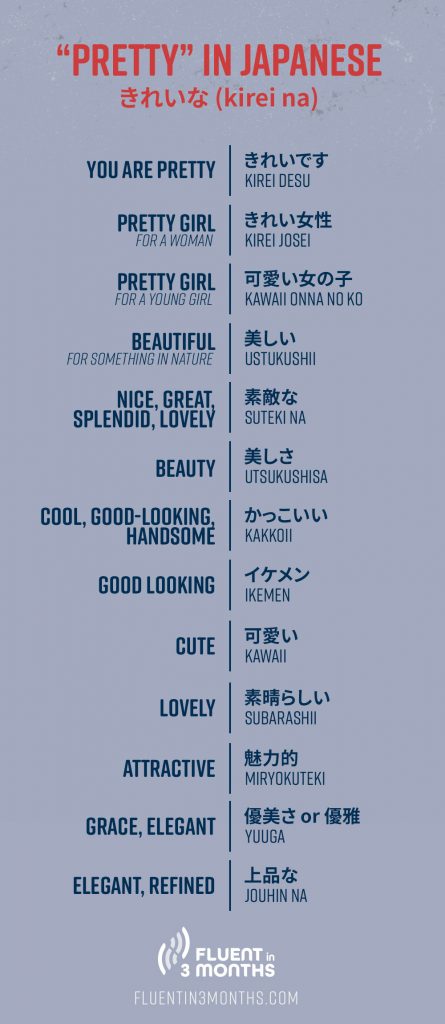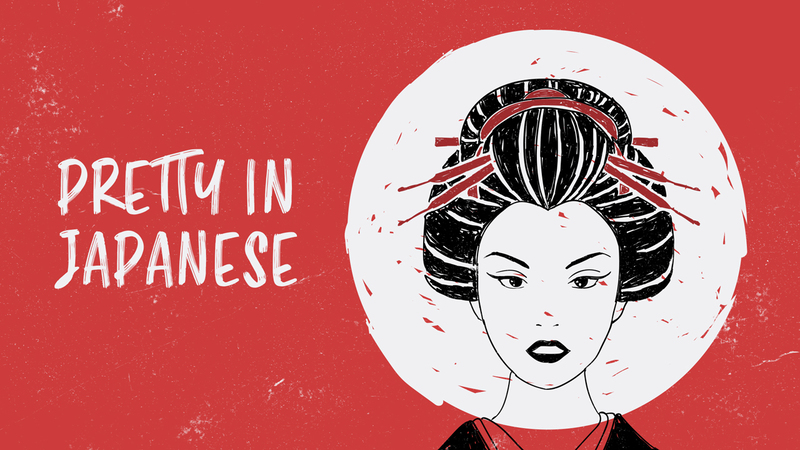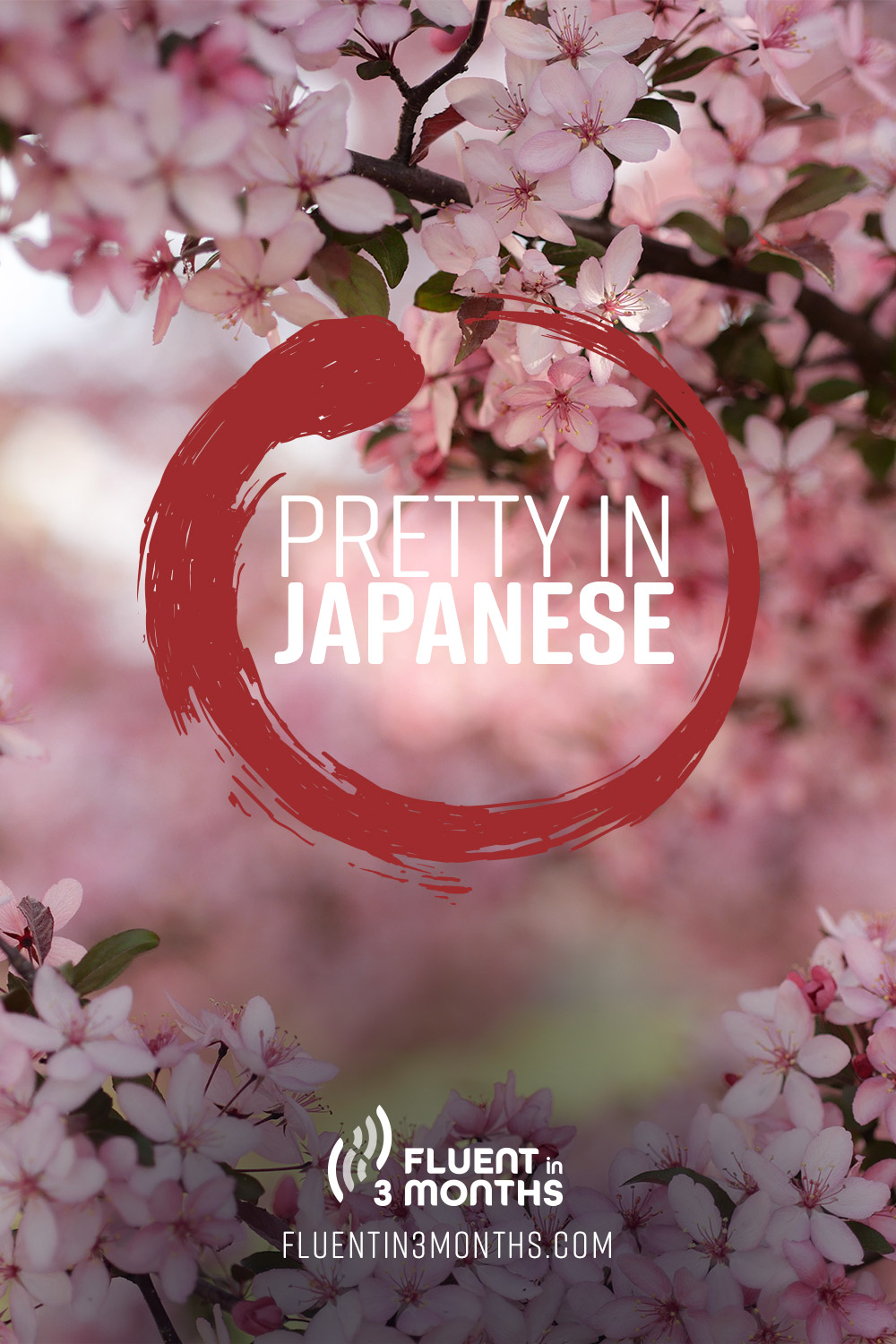“Pretty” in Japanese: How to Give a Compliment in Japanese
Wondering how to give a compliment and tell someone they look “pretty” in Japanese? I’ll teach you how in this article, and explain how to give a compliment based on gender, too.
Besides telling you how to say “pretty” in Japanese, I’ll explain how to give and receive compliments. I’ll also link to several of our other Japanese articles to help with any cultural or language insights related to the topic. So make sure to check them out, too!
Table of contents
How to Say “Pretty” in Japanese

“Pretty” in Japanese is きれいな (kirei na).
It’s a “na” adjective, meaning that the “na” is often dropped and it’s used with です (desu, “to be”).
So if you want to know how to say “you are pretty” in Japanese, you could simply say きれいです (kirei desu).
You could, of course, be more formal and add the proper pronoun or name like 君は / (name)-さんはきれいです。(*kimi wa / (name)-san wa kirei desu). But normally, it’s not needed.
In casual situations, it’s also fine to say only きれい!
As for how to say “pretty girl” in Japanese, you could say きれい女性 (kirei josei) for a woman. But it’s more natural to say 可愛い女の子 (kawaii onna no ko) for young girls, which uses the word for “cute” – more on that in a moment.
きれい also means “clean.” So it can also sometimes be used for men (to say something like they look “clean-cut”). And it’s used to describe a clean room or fresh space.
“Beautiful” in Japanese
If you want to tell someone they’re “beautiful” in Japanese, the most common word would still be きれい (kirei).
But there are two other words we could use: 美しい (utsukushii) and 素敵な (suteki na).
美しい (ustukushii) is used mainly to describe something beautiful in nature, like a beautiful cherry blossom tree or ocean view.
It can be used to describe a woman too, but it’s a very heavy word. It’s often saved for special occasions, like a wedding day.
In contrast, 素敵な (suteki na) can have several meanings, such as “nice”, “great”, “splendid”, “lovely”, “beautiful”, “cool”, “dreamy”… You get the idea.
素敵な (suteki na) is usually used in reaction to seeing or hearing something lovely. So when you see a friend who is wearing a beautiful new dress, you can say, “素敵!” (Just like きれい, you can drop the “na” in casual situations.)
For this reason, 素敵 (suteki) is more common than 美しい (utsukushii) when describing someone’s appearance. But one note: this word is more feminine.
That said, you could tell someone they have a beautiful smile (美しい笑顔, utsukushii egao) or beautiful face (美しい顔, utsukushii kao). Still, don’t overuse it.
And if you’re wondering, “beauty” in Japanese is 美しさ (utsukushisa).
Sometimes, you’ll hear 美少女 (bishoujo) which means “beautiful girl” and 美少年 (bishounen) for “beautiful boy”. But these are mainly used to describe anime characters. For real-life use, you’d use 美人 (bijin, “beautiful woman” or “person”).
“Handsome” in Japanese
In Japanese, if you want to compliment a guy, you’ll usually say he’s かっこいい (kakkoii). This means he’s “cool”, but also means he’s good-looking or handsome.
You can also use the loan word ハンサム (hansamu), or イケメン (ikemen) which is a slang term meaning “good looking.” It’s a Japanese portmanteau of イケてる (iketeru, “cool”) and メンズ (menzu, “men”).
Most people don’t use either of these directly to a person, but when talking about a person – especially idols.
You might say to a friend, 松本 潤はイケメンね (Mastumoto Jun wa ikemen ne), “Jun Mastumoto is good-looking, right??”
But you wouldn’t really tell someone they’re イケメン to their face.
Another way to compliment a man (or a woman for that matter), is to use 似合ってる (niatteru).
You could tell someone, 似合ってるだよ (niatteru da yo) which means “that suits you” or “it suits you.” It’s a nice way to tell someone their new outfit or accessory looks nice.
“Cute” in Japanese
To tell someone they’re cute in Japanese, you’d say 可愛い (kawaii).
In other countries, “cute” can sometimes be a bit condescending or negative when used to adult women. But in Japanese, kawaii culture is a big deal. And being “cute” is a very positive thing for any age.
In fact, “cute” has a whole ideal aesthetic that is very common and desirable in Japan! It’s also used to describe someone’s personality, saying they’re “charming.”
Boys can be 可愛い (kawaii) as well, but it’s more common for girls.
“Lovely” in Japanese
If you want to say something or someone is “lovely” in Japanese, use 素晴らしい (subarashii).
素晴らしい has several meanings and uses, such as “splendid”, “wonderful”, “amazing” and “magnificent.” But it can also mean that something is pleasant and lovely.
“Attractive” in Japanese
This word isn’t as common as some of the others. But to describe someone as attractive (or talk about what you find attractive), you’d use 魅力的 (miryokuteki).
魅力 (miryo) means “charm”, “glamour” and “appeal.” When you add 的 (teki), it means someone who has that trait.
For example:
彼女の笑顔は魅力的だと思う。
kanojo no egao wa miryokuteki da to omou
“I find her smile attractive.”
“Elegant” in Japanese
There are a few ways you can say “elegant” in Japanese – and it’s a great compliment. Besides cuteness, Japanese culture values elegant looks, behaviors, and items.
優美さ or 優雅 (yuuga) means both “grace” and “elegant”, while 上品な (jouhin na) means both “elegant” and “refined.”
Giving Compliments in Japanese
Japanese has many ways to tell someone they look pretty, but some Japanese words have heavier meanings than others.
In Japanese, some words like “beautiful” and “love” can be too serious for certain situations. In fact, saying “I love you” in Japanese is much more nuanced than in English.
So when it comes to giving a compliment, you want to make sure you do it the right way.
Don’t forget, too: Japanese is an honorific language. That means you need to have a basic understanding of Japanese conjugation for casual, polite, and formal speech to master giving a compliment. Some situations require more politeness than others.
And in general, most Japanese people will be shy or humble about it and reply with “いやいやいや” (iyaiyaiya, “no no no”) or something to that effect. It doesn’t mean they aren’t happy to have been complimented though!
As a general rule of thumb, Japanese people take compliments best when it’s less direct and specific. For example, instead of saying, “You look so beautiful/handsome!”, you could say “Your makeup/hairstyle looks so good today!”
So How to Give Compliments in Japanese?
Let’s talk a bit more about how to do it the right way.
Japanese culture is quite reserved. They value being humble and modest, so compliments can be tricky.
Compliments (especially among women) can be quite common, but usually simple and sometimes just small-talk flattery. Compliments aren’t as common among or from men.
So if you’re a guy, it might come off a bit weird to give a compliment to another guy outside of something like お疲れ (otsukare, “you must be tired (from all the work you did)” which basically means “good job today”). And if you’re a girl complimenting a guy, it might be taken as romantic interest.
That’s why it’s best if compliments are indirect and mild. This is why some language sounds too “heavy” for some situations, and if overused, comes off as too serious or insincere.
For example, instead of complimenting someone’s dress, you could compliment their taste in fashion. Or, if you do compliment the dress, you could say something like:
ワンピースがいいねー
wan pi-su ga ii ne-
“Your dress is nice.”
いいね (ii ne) is a common, nice, and simple compliment for almost any situation.
Other examples of compliments that can almost always work:
- ありがとう、優しい, arigatou, yasashii: “Thank you, you’re so kind”
- 上手だね, jouzu da ne: “You’re good at this” or “You’re talented/skilled”
- すごい, sugoi: “Wow!” or “Amazing!” It’s multifunctional, but a bit generic and overused
- お疲れ様でした, otsukarasama deshita: “You worked hard” or “thank you for your hard work”
- 美味しい, oishii or うまい, umai: Meaning “delicious” and “good” respectively, ALWAYS compliment the food!
- 似合う, niau: “to suit” or “looks good.” Always a great and simple way to compliment someone
Sometimes comments on appearance are too straightforward. So going this route of complimenting skills, personalities, or saying something suits them is a better way to go.
How to Take a Compliment in Japanese
Now, what about when it comes to receiving a compliment yourself? How do Japanese people respond to compliments?
While there are some tides of change here, in general, saying “thank you” for a compliment is actually considered a bit rude.
No, really!
It’s seen as saying, “thanks (for noticing how amazing/beautiful/cool I am)” instead of just saying “thanks (for being kind)”.
It’s seen as not being humble if you’re quick to accept the compliment, like you know it’s true.
In general, you’ll be met with one of these common reactions:
- そんなことありません, sonna koto arimasen: “That’s not the case”
- 全然そんなことないよ, zenzen sonna koto nai yo: “That’s not the case at all” (more casual, stronger denial than the last one)
- いいえ / ううん, iie / uun: “No”
- いやいやいや, iyaiyaiya: “No, no, no”
Don’t forget to wave your hand in front of your face when denying your compliment!
If you’d rather though, you could use a phrase that’s a better balance of being humble and thanking for the kind words.
SoraNews24 shared a few examples from a Japanese Twitter thread, such as:
- 恐れ入ります, osoreirimasu: “Excuse me (for the trouble)” and an expression of gratitude in one
- 全然そんなことないけど嬉しいです, zenzen koto nai kedo ureshii desu: “Not at all, but I’m happy (you think so/told me/said that).”
But if it’s between close friends, it’s okay to keep it more casual or even joke around.
Go Compliment Someone in Japanese!
Whether you tell someone they’re きれい (kirei) – “pretty” – in Japanese or use the ol’ standby いいね (ii ne), It’s always a good time to spread cheer and kindness, so put a smile on someone’s face!
Now that you’ve learned how to give someone a compliment, here are some Japanese lessons you might enjoy next:




Social